Comprehensive Research Report on Electronic Data Interchange (EDI)
VerifiedAdded on 2023/06/07
|15
|3811
|80
Report
AI Summary
This research report provides a comprehensive analysis of Electronic Data Interchange (EDI), focusing on its methodology, results, and findings. The research employs primary data analysis, utilizing electronic questionnaires distributed to businesses to assess factors influencing EDI implementation. Statistical methods, including Chi-square tests and factor analysis, are used to interpret the data. Key findings reveal varying levels of awareness and adoption of EDI among businesses, with email remaining a prevalent communication method. The report identifies motivators such as increased productivity and reduced error rates, as well as drawbacks like limited penetration and implementation costs. The analysis explores relationships between perceived advantages of EDI and factors like IT knowledge management and company awareness. Ultimately, the report offers insights into the primary factors affecting EDI adoption and provides recommendations for improved implementation.
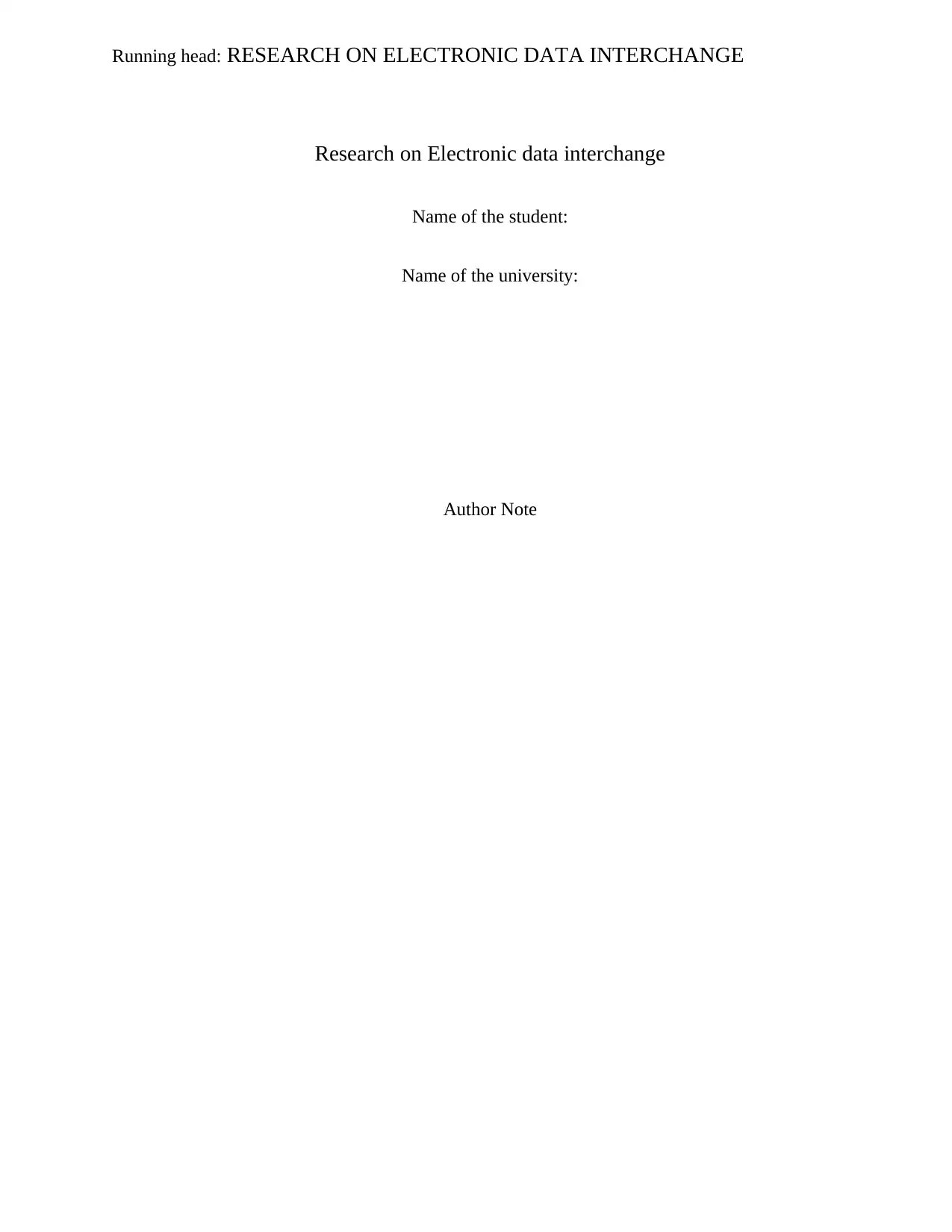
Running head: RESEARCH ON ELECTRONIC DATA INTERCHANGE
Research on Electronic data interchange
Name of the student:
Name of the university:
Author Note
Research on Electronic data interchange
Name of the student:
Name of the university:
Author Note
Paraphrase This Document
Need a fresh take? Get an instant paraphrase of this document with our AI Paraphraser
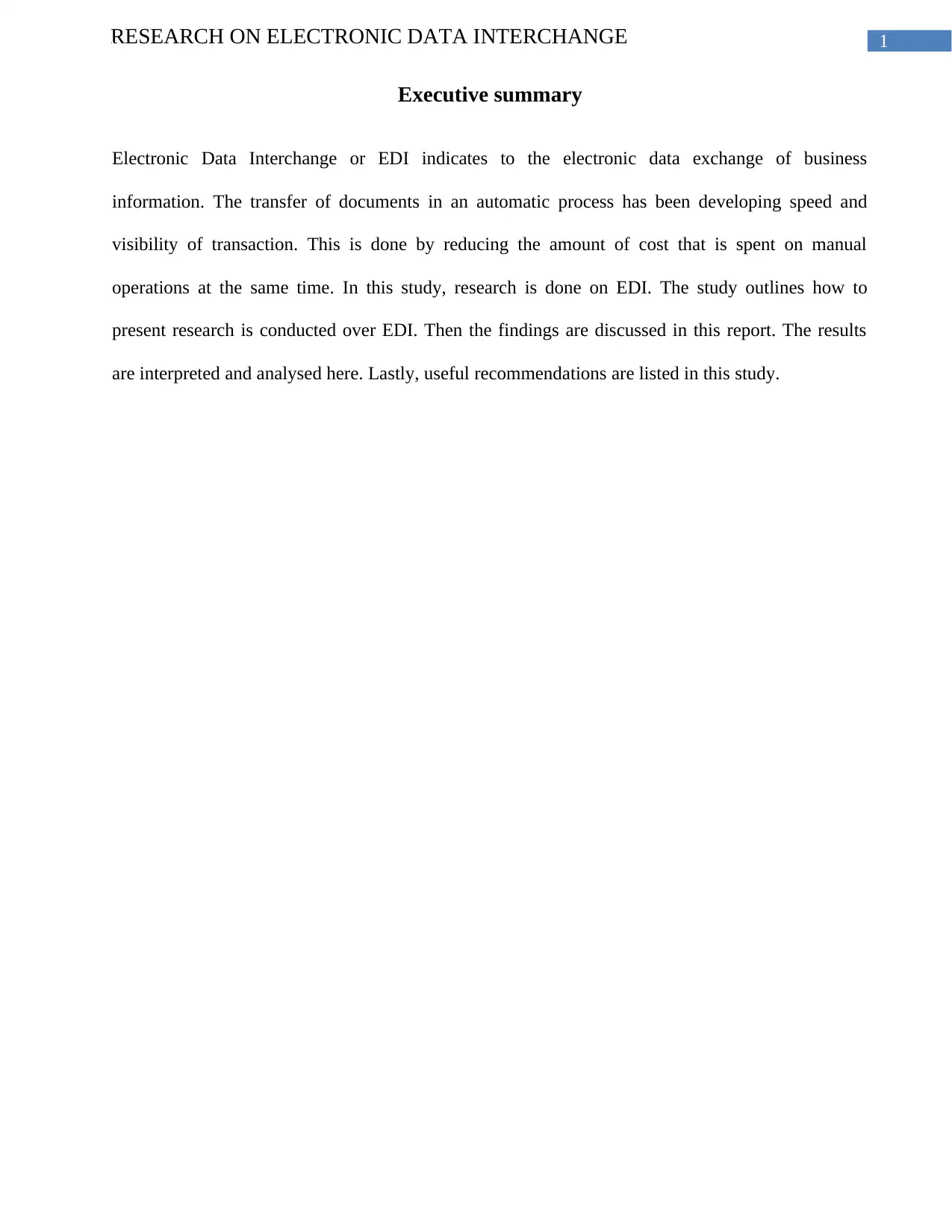
1RESEARCH ON ELECTRONIC DATA INTERCHANGE
Executive summary
Electronic Data Interchange or EDI indicates to the electronic data exchange of business
information. The transfer of documents in an automatic process has been developing speed and
visibility of transaction. This is done by reducing the amount of cost that is spent on manual
operations at the same time. In this study, research is done on EDI. The study outlines how to
present research is conducted over EDI. Then the findings are discussed in this report. The results
are interpreted and analysed here. Lastly, useful recommendations are listed in this study.
Executive summary
Electronic Data Interchange or EDI indicates to the electronic data exchange of business
information. The transfer of documents in an automatic process has been developing speed and
visibility of transaction. This is done by reducing the amount of cost that is spent on manual
operations at the same time. In this study, research is done on EDI. The study outlines how to
present research is conducted over EDI. Then the findings are discussed in this report. The results
are interpreted and analysed here. Lastly, useful recommendations are listed in this study.
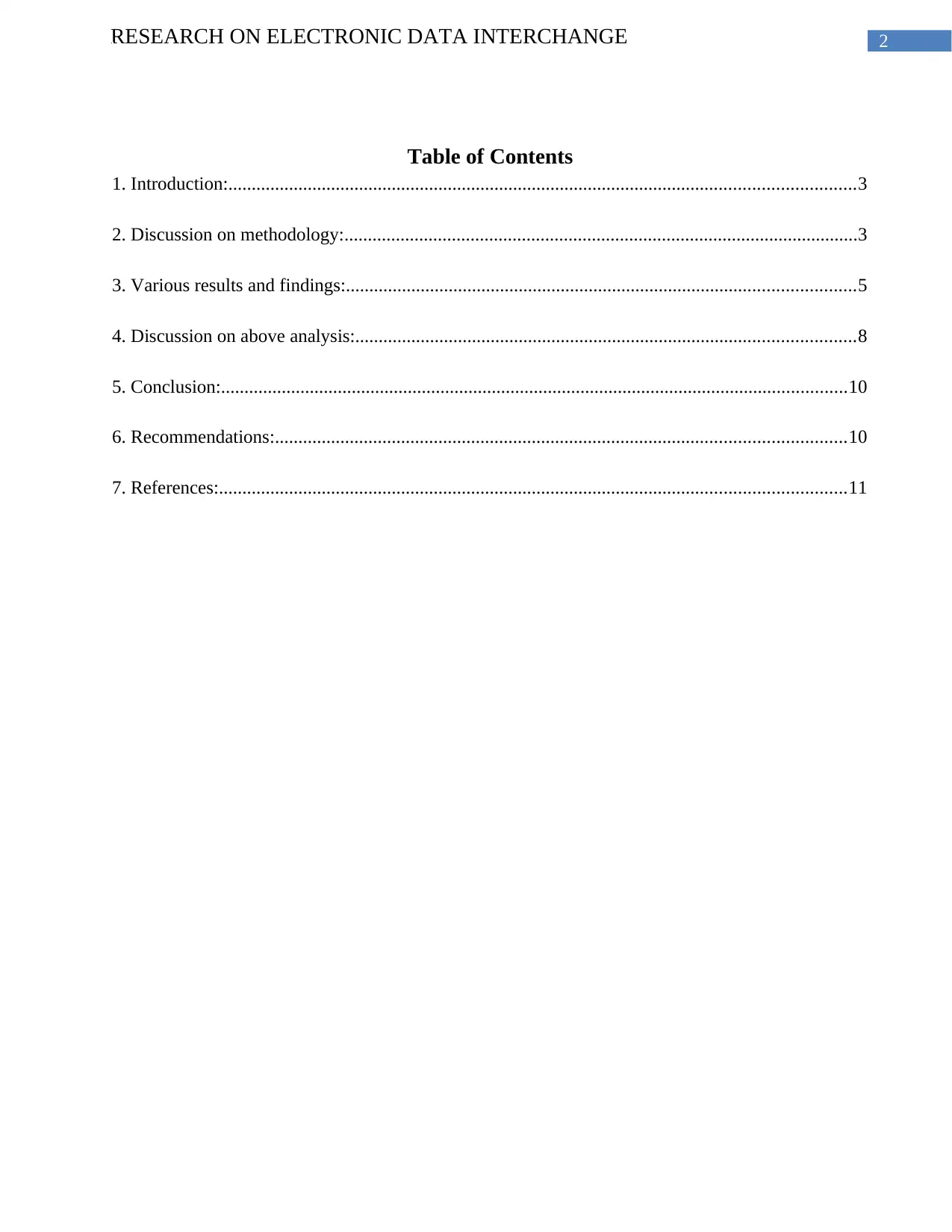
2RESEARCH ON ELECTRONIC DATA INTERCHANGE
Table of Contents
1. Introduction:......................................................................................................................................3
2. Discussion on methodology:..............................................................................................................3
3. Various results and findings:.............................................................................................................5
4. Discussion on above analysis:...........................................................................................................8
5. Conclusion:......................................................................................................................................10
6. Recommendations:..........................................................................................................................10
7. References:......................................................................................................................................11
Table of Contents
1. Introduction:......................................................................................................................................3
2. Discussion on methodology:..............................................................................................................3
3. Various results and findings:.............................................................................................................5
4. Discussion on above analysis:...........................................................................................................8
5. Conclusion:......................................................................................................................................10
6. Recommendations:..........................................................................................................................10
7. References:......................................................................................................................................11
⊘ This is a preview!⊘
Do you want full access?
Subscribe today to unlock all pages.

Trusted by 1+ million students worldwide
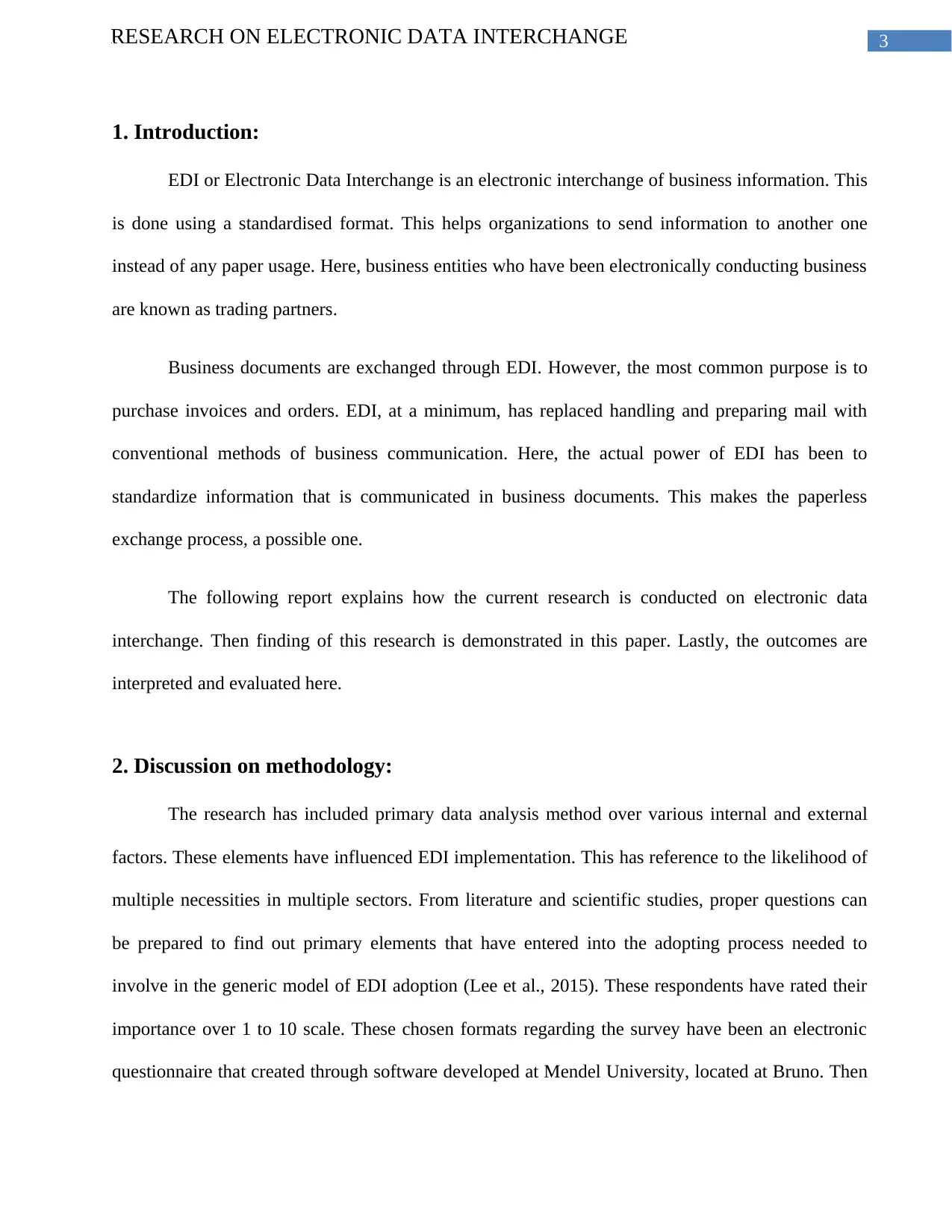
3RESEARCH ON ELECTRONIC DATA INTERCHANGE
1. Introduction:
EDI or Electronic Data Interchange is an electronic interchange of business information. This
is done using a standardised format. This helps organizations to send information to another one
instead of any paper usage. Here, business entities who have been electronically conducting business
are known as trading partners.
Business documents are exchanged through EDI. However, the most common purpose is to
purchase invoices and orders. EDI, at a minimum, has replaced handling and preparing mail with
conventional methods of business communication. Here, the actual power of EDI has been to
standardize information that is communicated in business documents. This makes the paperless
exchange process, a possible one.
The following report explains how the current research is conducted on electronic data
interchange. Then finding of this research is demonstrated in this paper. Lastly, the outcomes are
interpreted and evaluated here.
2. Discussion on methodology:
The research has included primary data analysis method over various internal and external
factors. These elements have influenced EDI implementation. This has reference to the likelihood of
multiple necessities in multiple sectors. From literature and scientific studies, proper questions can
be prepared to find out primary elements that have entered into the adopting process needed to
involve in the generic model of EDI adoption (Lee et al., 2015). These respondents have rated their
importance over 1 to 10 scale. These chosen formats regarding the survey have been an electronic
questionnaire that created through software developed at Mendel University, located at Bruno. Then
1. Introduction:
EDI or Electronic Data Interchange is an electronic interchange of business information. This
is done using a standardised format. This helps organizations to send information to another one
instead of any paper usage. Here, business entities who have been electronically conducting business
are known as trading partners.
Business documents are exchanged through EDI. However, the most common purpose is to
purchase invoices and orders. EDI, at a minimum, has replaced handling and preparing mail with
conventional methods of business communication. Here, the actual power of EDI has been to
standardize information that is communicated in business documents. This makes the paperless
exchange process, a possible one.
The following report explains how the current research is conducted on electronic data
interchange. Then finding of this research is demonstrated in this paper. Lastly, the outcomes are
interpreted and evaluated here.
2. Discussion on methodology:
The research has included primary data analysis method over various internal and external
factors. These elements have influenced EDI implementation. This has reference to the likelihood of
multiple necessities in multiple sectors. From literature and scientific studies, proper questions can
be prepared to find out primary elements that have entered into the adopting process needed to
involve in the generic model of EDI adoption (Lee et al., 2015). These respondents have rated their
importance over 1 to 10 scale. These chosen formats regarding the survey have been an electronic
questionnaire that created through software developed at Mendel University, located at Bruno. Then
Paraphrase This Document
Need a fresh take? Get an instant paraphrase of this document with our AI Paraphraser
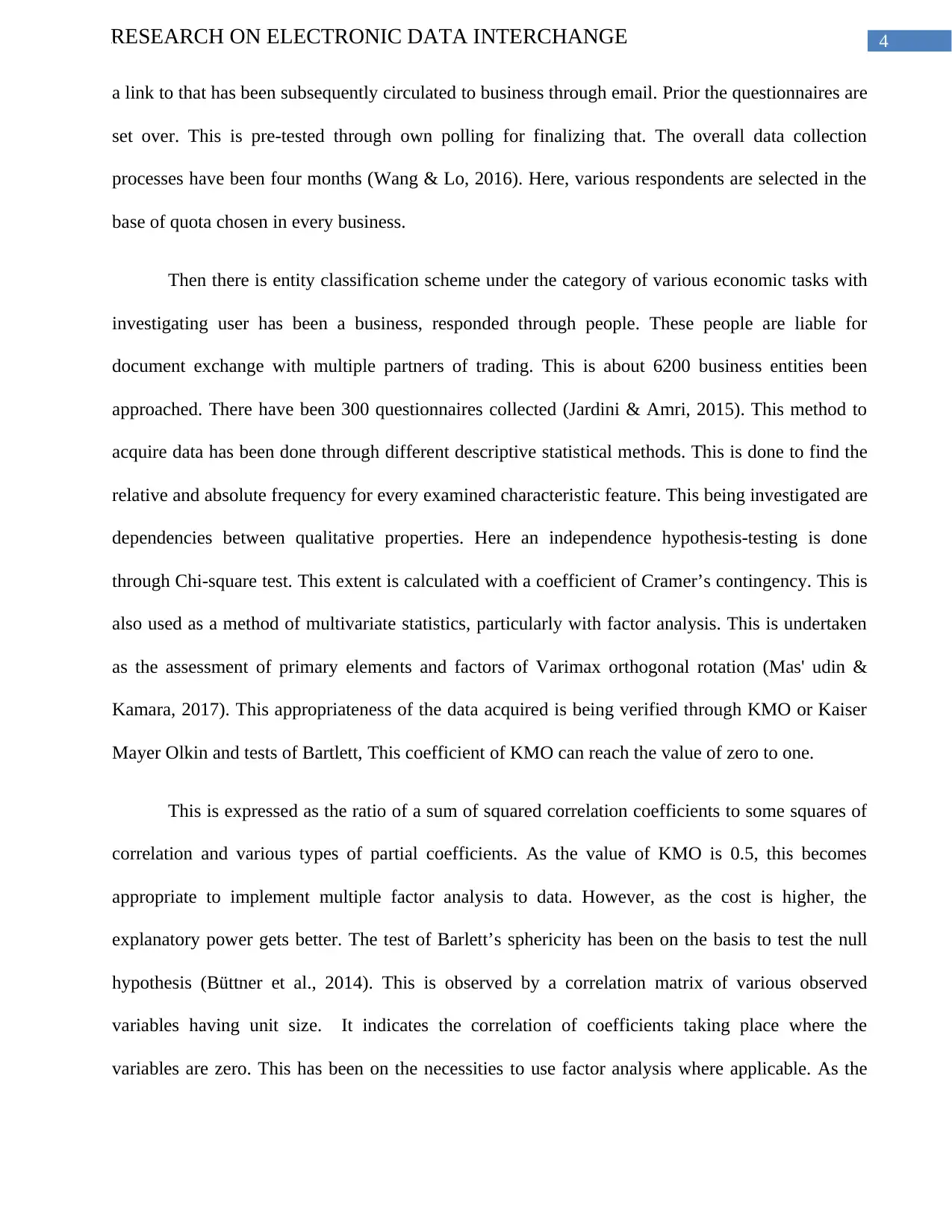
4RESEARCH ON ELECTRONIC DATA INTERCHANGE
a link to that has been subsequently circulated to business through email. Prior the questionnaires are
set over. This is pre-tested through own polling for finalizing that. The overall data collection
processes have been four months (Wang & Lo, 2016). Here, various respondents are selected in the
base of quota chosen in every business.
Then there is entity classification scheme under the category of various economic tasks with
investigating user has been a business, responded through people. These people are liable for
document exchange with multiple partners of trading. This is about 6200 business entities been
approached. There have been 300 questionnaires collected (Jardini & Amri, 2015). This method to
acquire data has been done through different descriptive statistical methods. This is done to find the
relative and absolute frequency for every examined characteristic feature. This being investigated are
dependencies between qualitative properties. Here an independence hypothesis-testing is done
through Chi-square test. This extent is calculated with a coefficient of Cramer’s contingency. This is
also used as a method of multivariate statistics, particularly with factor analysis. This is undertaken
as the assessment of primary elements and factors of Varimax orthogonal rotation (Mas' udin &
Kamara, 2017). This appropriateness of the data acquired is being verified through KMO or Kaiser
Mayer Olkin and tests of Bartlett, This coefficient of KMO can reach the value of zero to one.
This is expressed as the ratio of a sum of squared correlation coefficients to some squares of
correlation and various types of partial coefficients. As the value of KMO is 0.5, this becomes
appropriate to implement multiple factor analysis to data. However, as the cost is higher, the
explanatory power gets better. The test of Barlett’s sphericity has been on the basis to test the null
hypothesis (Büttner et al., 2014). This is observed by a correlation matrix of various observed
variables having unit size. It indicates the correlation of coefficients taking place where the
variables are zero. This has been on the necessities to use factor analysis where applicable. As the
a link to that has been subsequently circulated to business through email. Prior the questionnaires are
set over. This is pre-tested through own polling for finalizing that. The overall data collection
processes have been four months (Wang & Lo, 2016). Here, various respondents are selected in the
base of quota chosen in every business.
Then there is entity classification scheme under the category of various economic tasks with
investigating user has been a business, responded through people. These people are liable for
document exchange with multiple partners of trading. This is about 6200 business entities been
approached. There have been 300 questionnaires collected (Jardini & Amri, 2015). This method to
acquire data has been done through different descriptive statistical methods. This is done to find the
relative and absolute frequency for every examined characteristic feature. This being investigated are
dependencies between qualitative properties. Here an independence hypothesis-testing is done
through Chi-square test. This extent is calculated with a coefficient of Cramer’s contingency. This is
also used as a method of multivariate statistics, particularly with factor analysis. This is undertaken
as the assessment of primary elements and factors of Varimax orthogonal rotation (Mas' udin &
Kamara, 2017). This appropriateness of the data acquired is being verified through KMO or Kaiser
Mayer Olkin and tests of Bartlett, This coefficient of KMO can reach the value of zero to one.
This is expressed as the ratio of a sum of squared correlation coefficients to some squares of
correlation and various types of partial coefficients. As the value of KMO is 0.5, this becomes
appropriate to implement multiple factor analysis to data. However, as the cost is higher, the
explanatory power gets better. The test of Barlett’s sphericity has been on the basis to test the null
hypothesis (Büttner et al., 2014). This is observed by a correlation matrix of various observed
variables having unit size. It indicates the correlation of coefficients taking place where the
variables are zero. This has been on the necessities to use factor analysis where applicable. As the
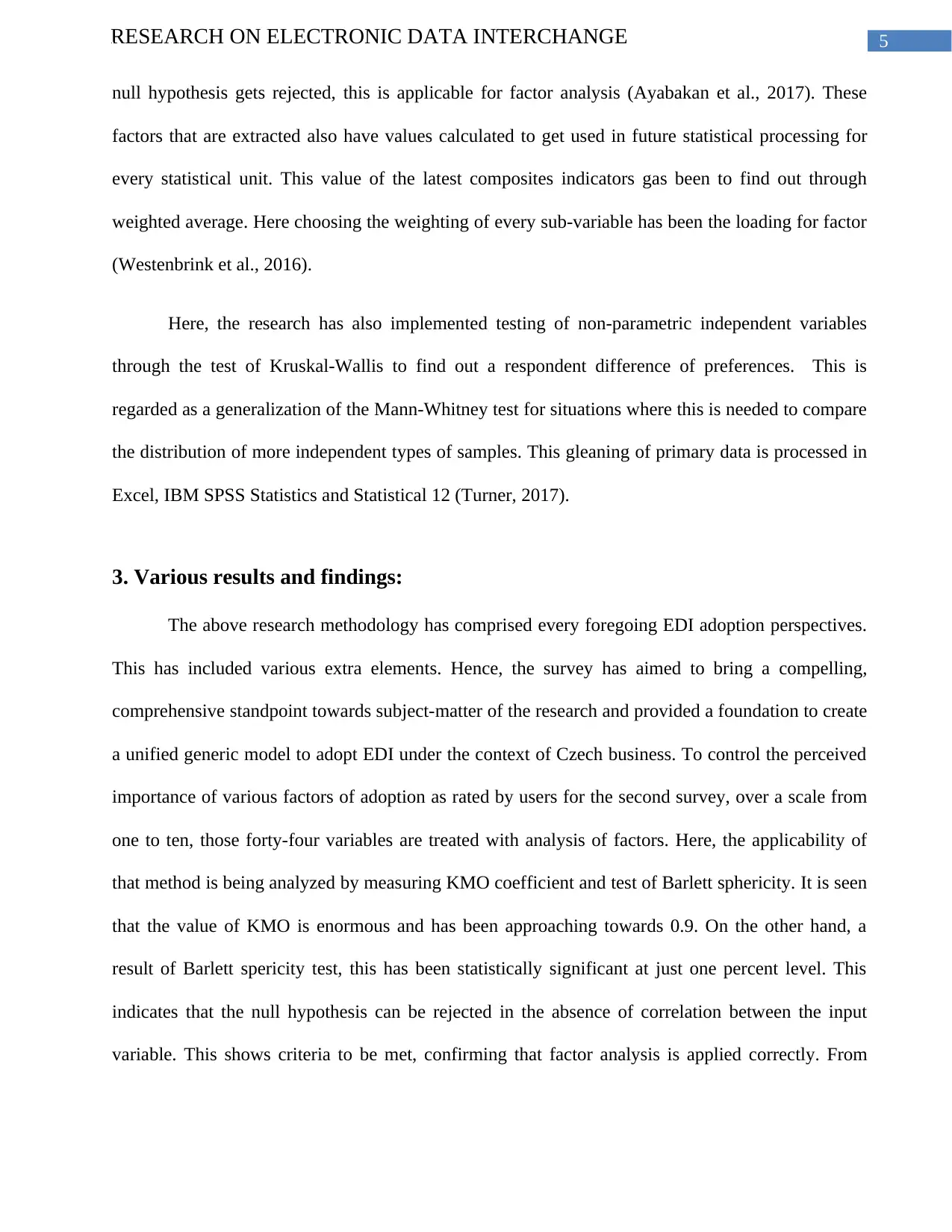
5RESEARCH ON ELECTRONIC DATA INTERCHANGE
null hypothesis gets rejected, this is applicable for factor analysis (Ayabakan et al., 2017). These
factors that are extracted also have values calculated to get used in future statistical processing for
every statistical unit. This value of the latest composites indicators gas been to find out through
weighted average. Here choosing the weighting of every sub-variable has been the loading for factor
(Westenbrink et al., 2016).
Here, the research has also implemented testing of non-parametric independent variables
through the test of Kruskal-Wallis to find out a respondent difference of preferences. This is
regarded as a generalization of the Mann-Whitney test for situations where this is needed to compare
the distribution of more independent types of samples. This gleaning of primary data is processed in
Excel, IBM SPSS Statistics and Statistical 12 (Turner, 2017).
3. Various results and findings:
The above research methodology has comprised every foregoing EDI adoption perspectives.
This has included various extra elements. Hence, the survey has aimed to bring a compelling,
comprehensive standpoint towards subject-matter of the research and provided a foundation to create
a unified generic model to adopt EDI under the context of Czech business. To control the perceived
importance of various factors of adoption as rated by users for the second survey, over a scale from
one to ten, those forty-four variables are treated with analysis of factors. Here, the applicability of
that method is being analyzed by measuring KMO coefficient and test of Barlett sphericity. It is seen
that the value of KMO is enormous and has been approaching towards 0.9. On the other hand, a
result of Barlett spericity test, this has been statistically significant at just one percent level. This
indicates that the null hypothesis can be rejected in the absence of correlation between the input
variable. This shows criteria to be met, confirming that factor analysis is applied correctly. From
null hypothesis gets rejected, this is applicable for factor analysis (Ayabakan et al., 2017). These
factors that are extracted also have values calculated to get used in future statistical processing for
every statistical unit. This value of the latest composites indicators gas been to find out through
weighted average. Here choosing the weighting of every sub-variable has been the loading for factor
(Westenbrink et al., 2016).
Here, the research has also implemented testing of non-parametric independent variables
through the test of Kruskal-Wallis to find out a respondent difference of preferences. This is
regarded as a generalization of the Mann-Whitney test for situations where this is needed to compare
the distribution of more independent types of samples. This gleaning of primary data is processed in
Excel, IBM SPSS Statistics and Statistical 12 (Turner, 2017).
3. Various results and findings:
The above research methodology has comprised every foregoing EDI adoption perspectives.
This has included various extra elements. Hence, the survey has aimed to bring a compelling,
comprehensive standpoint towards subject-matter of the research and provided a foundation to create
a unified generic model to adopt EDI under the context of Czech business. To control the perceived
importance of various factors of adoption as rated by users for the second survey, over a scale from
one to ten, those forty-four variables are treated with analysis of factors. Here, the applicability of
that method is being analyzed by measuring KMO coefficient and test of Barlett sphericity. It is seen
that the value of KMO is enormous and has been approaching towards 0.9. On the other hand, a
result of Barlett spericity test, this has been statistically significant at just one percent level. This
indicates that the null hypothesis can be rejected in the absence of correlation between the input
variable. This shows criteria to be met, confirming that factor analysis is applied correctly. From
⊘ This is a preview!⊘
Do you want full access?
Subscribe today to unlock all pages.

Trusted by 1+ million students worldwide
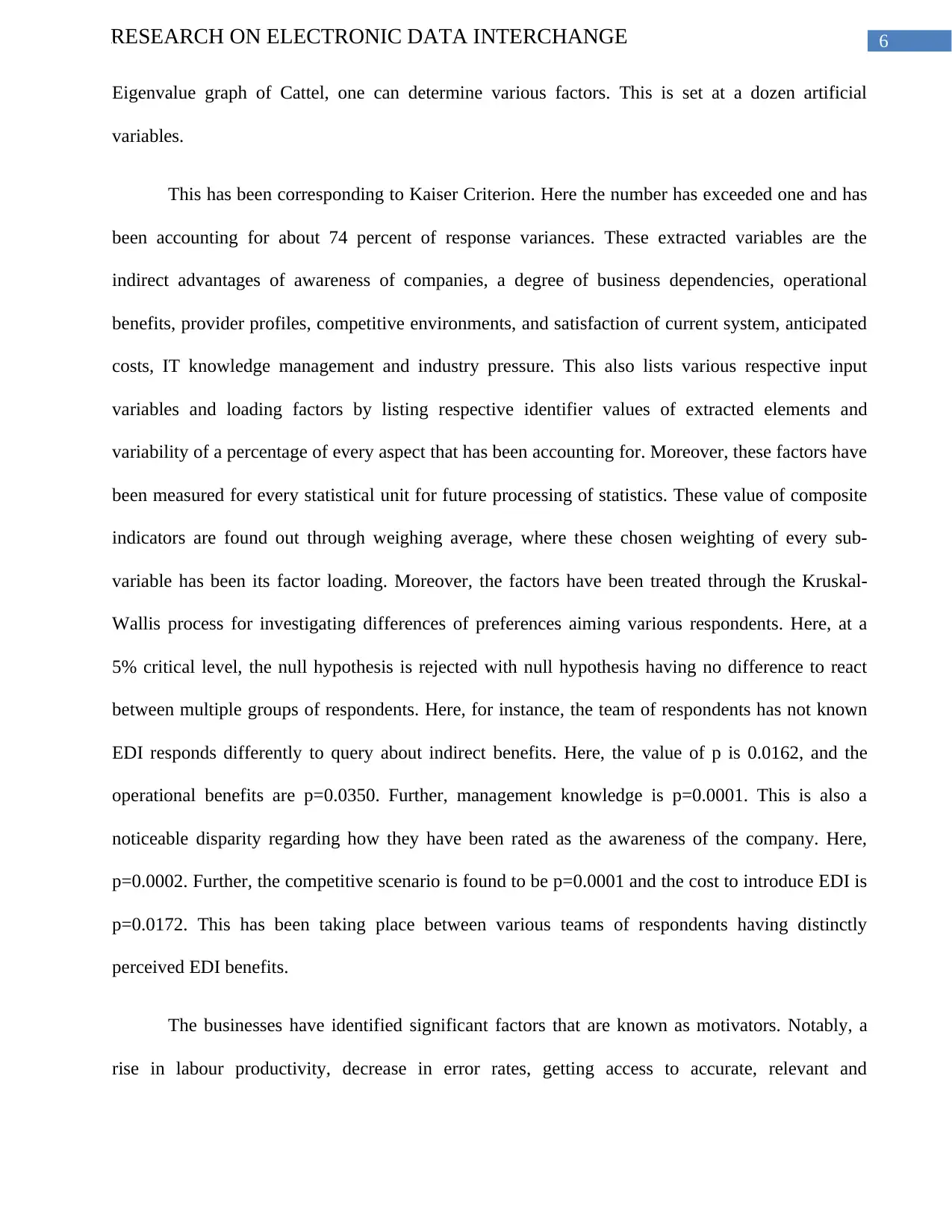
6RESEARCH ON ELECTRONIC DATA INTERCHANGE
Eigenvalue graph of Cattel, one can determine various factors. This is set at a dozen artificial
variables.
This has been corresponding to Kaiser Criterion. Here the number has exceeded one and has
been accounting for about 74 percent of response variances. These extracted variables are the
indirect advantages of awareness of companies, a degree of business dependencies, operational
benefits, provider profiles, competitive environments, and satisfaction of current system, anticipated
costs, IT knowledge management and industry pressure. This also lists various respective input
variables and loading factors by listing respective identifier values of extracted elements and
variability of a percentage of every aspect that has been accounting for. Moreover, these factors have
been measured for every statistical unit for future processing of statistics. These value of composite
indicators are found out through weighing average, where these chosen weighting of every sub-
variable has been its factor loading. Moreover, the factors have been treated through the Kruskal-
Wallis process for investigating differences of preferences aiming various respondents. Here, at a
5% critical level, the null hypothesis is rejected with null hypothesis having no difference to react
between multiple groups of respondents. Here, for instance, the team of respondents has not known
EDI responds differently to query about indirect benefits. Here, the value of p is 0.0162, and the
operational benefits are p=0.0350. Further, management knowledge is p=0.0001. This is also a
noticeable disparity regarding how they have been rated as the awareness of the company. Here,
p=0.0002. Further, the competitive scenario is found to be p=0.0001 and the cost to introduce EDI is
p=0.0172. This has been taking place between various teams of respondents having distinctly
perceived EDI benefits.
The businesses have identified significant factors that are known as motivators. Notably, a
rise in labour productivity, decrease in error rates, getting access to accurate, relevant and
Eigenvalue graph of Cattel, one can determine various factors. This is set at a dozen artificial
variables.
This has been corresponding to Kaiser Criterion. Here the number has exceeded one and has
been accounting for about 74 percent of response variances. These extracted variables are the
indirect advantages of awareness of companies, a degree of business dependencies, operational
benefits, provider profiles, competitive environments, and satisfaction of current system, anticipated
costs, IT knowledge management and industry pressure. This also lists various respective input
variables and loading factors by listing respective identifier values of extracted elements and
variability of a percentage of every aspect that has been accounting for. Moreover, these factors have
been measured for every statistical unit for future processing of statistics. These value of composite
indicators are found out through weighing average, where these chosen weighting of every sub-
variable has been its factor loading. Moreover, the factors have been treated through the Kruskal-
Wallis process for investigating differences of preferences aiming various respondents. Here, at a
5% critical level, the null hypothesis is rejected with null hypothesis having no difference to react
between multiple groups of respondents. Here, for instance, the team of respondents has not known
EDI responds differently to query about indirect benefits. Here, the value of p is 0.0162, and the
operational benefits are p=0.0350. Further, management knowledge is p=0.0001. This is also a
noticeable disparity regarding how they have been rated as the awareness of the company. Here,
p=0.0002. Further, the competitive scenario is found to be p=0.0001 and the cost to introduce EDI is
p=0.0172. This has been taking place between various teams of respondents having distinctly
perceived EDI benefits.
The businesses have identified significant factors that are known as motivators. Notably, a
rise in labour productivity, decrease in error rates, getting access to accurate, relevant and
Paraphrase This Document
Need a fresh take? Get an instant paraphrase of this document with our AI Paraphraser
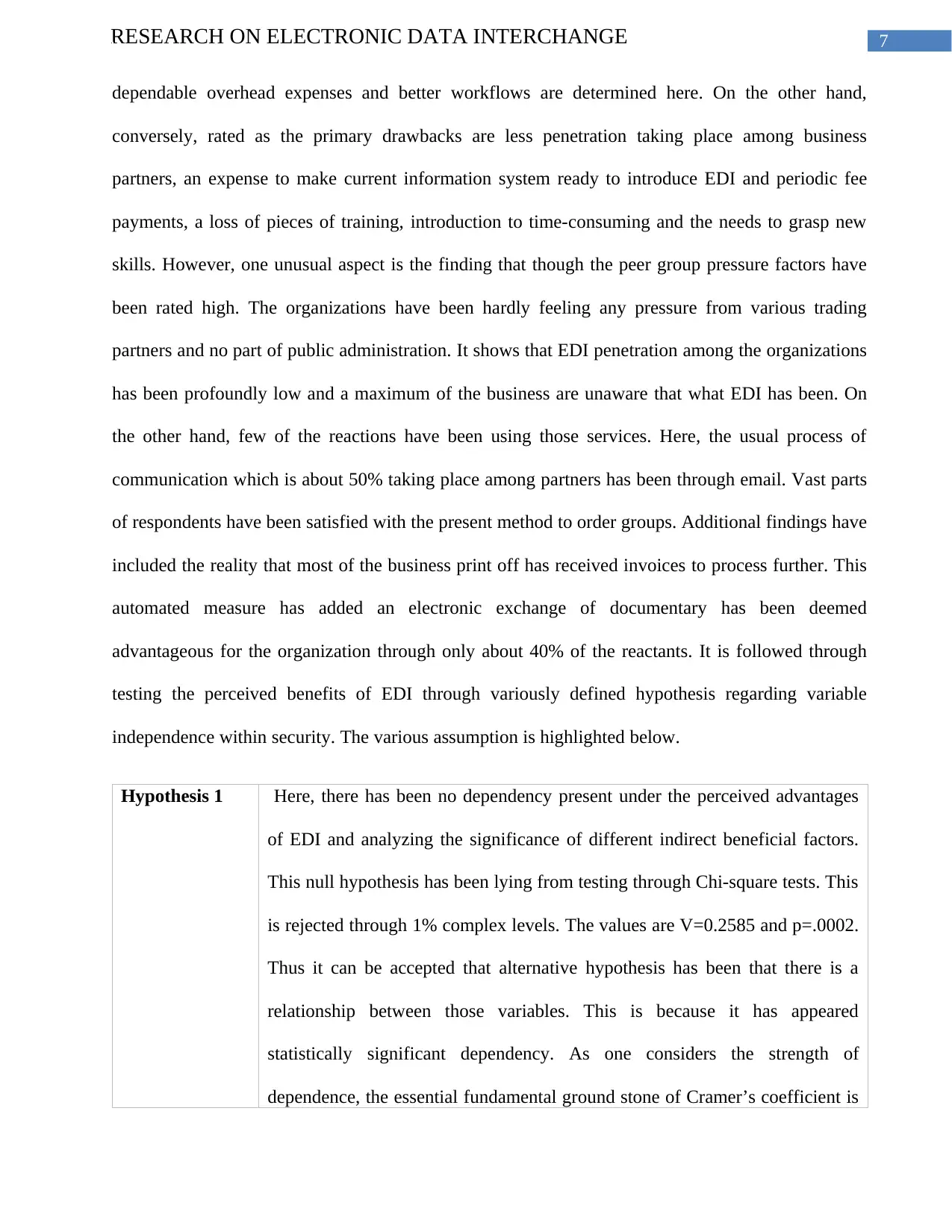
7RESEARCH ON ELECTRONIC DATA INTERCHANGE
dependable overhead expenses and better workflows are determined here. On the other hand,
conversely, rated as the primary drawbacks are less penetration taking place among business
partners, an expense to make current information system ready to introduce EDI and periodic fee
payments, a loss of pieces of training, introduction to time-consuming and the needs to grasp new
skills. However, one unusual aspect is the finding that though the peer group pressure factors have
been rated high. The organizations have been hardly feeling any pressure from various trading
partners and no part of public administration. It shows that EDI penetration among the organizations
has been profoundly low and a maximum of the business are unaware that what EDI has been. On
the other hand, few of the reactions have been using those services. Here, the usual process of
communication which is about 50% taking place among partners has been through email. Vast parts
of respondents have been satisfied with the present method to order groups. Additional findings have
included the reality that most of the business print off has received invoices to process further. This
automated measure has added an electronic exchange of documentary has been deemed
advantageous for the organization through only about 40% of the reactants. It is followed through
testing the perceived benefits of EDI through variously defined hypothesis regarding variable
independence within security. The various assumption is highlighted below.
Hypothesis 1 Here, there has been no dependency present under the perceived advantages
of EDI and analyzing the significance of different indirect beneficial factors.
This null hypothesis has been lying from testing through Chi-square tests. This
is rejected through 1% complex levels. The values are V=0.2585 and p=.0002.
Thus it can be accepted that alternative hypothesis has been that there is a
relationship between those variables. This is because it has appeared
statistically significant dependency. As one considers the strength of
dependence, the essential fundamental ground stone of Cramer’s coefficient is
dependable overhead expenses and better workflows are determined here. On the other hand,
conversely, rated as the primary drawbacks are less penetration taking place among business
partners, an expense to make current information system ready to introduce EDI and periodic fee
payments, a loss of pieces of training, introduction to time-consuming and the needs to grasp new
skills. However, one unusual aspect is the finding that though the peer group pressure factors have
been rated high. The organizations have been hardly feeling any pressure from various trading
partners and no part of public administration. It shows that EDI penetration among the organizations
has been profoundly low and a maximum of the business are unaware that what EDI has been. On
the other hand, few of the reactions have been using those services. Here, the usual process of
communication which is about 50% taking place among partners has been through email. Vast parts
of respondents have been satisfied with the present method to order groups. Additional findings have
included the reality that most of the business print off has received invoices to process further. This
automated measure has added an electronic exchange of documentary has been deemed
advantageous for the organization through only about 40% of the reactants. It is followed through
testing the perceived benefits of EDI through variously defined hypothesis regarding variable
independence within security. The various assumption is highlighted below.
Hypothesis 1 Here, there has been no dependency present under the perceived advantages
of EDI and analyzing the significance of different indirect beneficial factors.
This null hypothesis has been lying from testing through Chi-square tests. This
is rejected through 1% complex levels. The values are V=0.2585 and p=.0002.
Thus it can be accepted that alternative hypothesis has been that there is a
relationship between those variables. This is because it has appeared
statistically significant dependency. As one considers the strength of
dependence, the essential fundamental ground stone of Cramer’s coefficient is
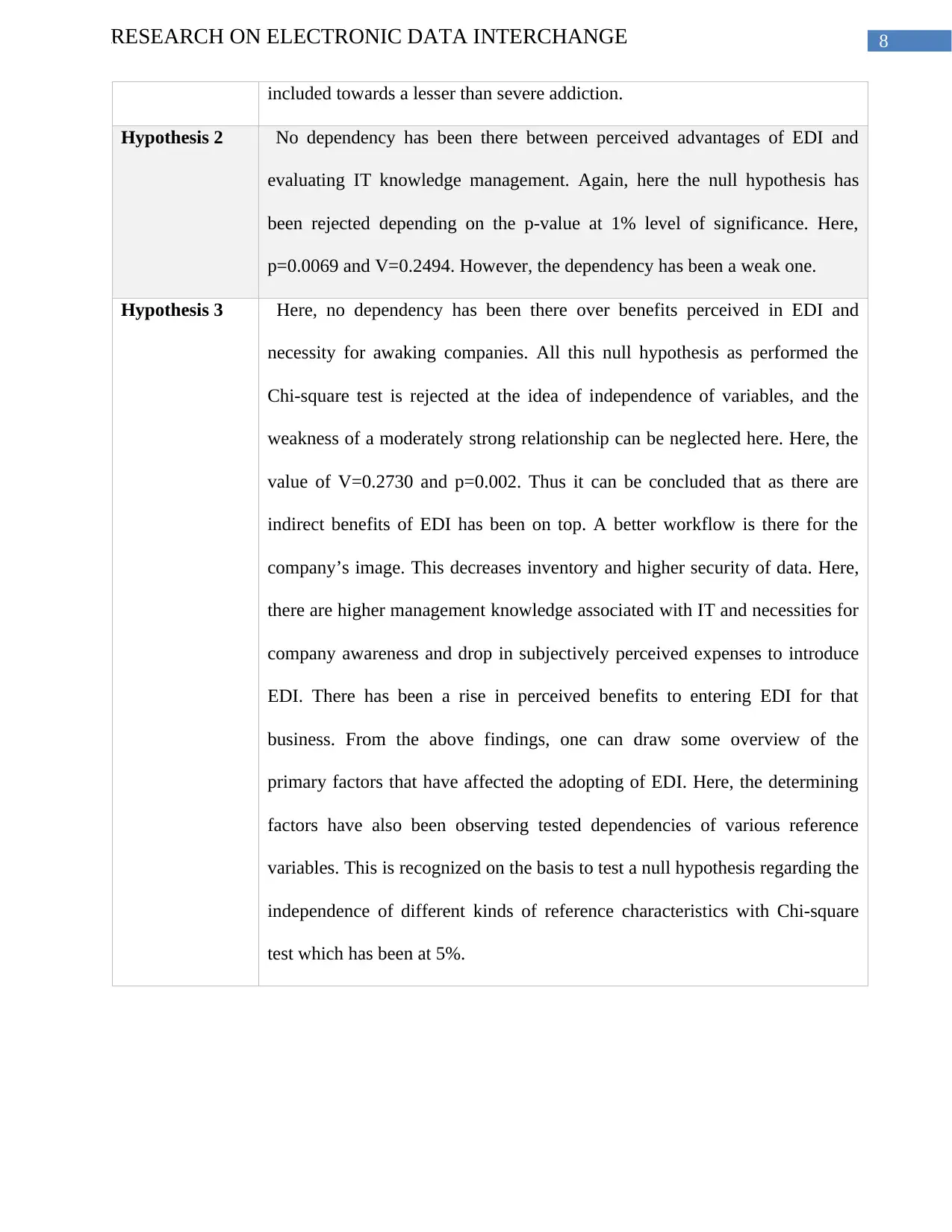
8RESEARCH ON ELECTRONIC DATA INTERCHANGE
included towards a lesser than severe addiction.
Hypothesis 2 No dependency has been there between perceived advantages of EDI and
evaluating IT knowledge management. Again, here the null hypothesis has
been rejected depending on the p-value at 1% level of significance. Here,
p=0.0069 and V=0.2494. However, the dependency has been a weak one.
Hypothesis 3 Here, no dependency has been there over benefits perceived in EDI and
necessity for awaking companies. All this null hypothesis as performed the
Chi-square test is rejected at the idea of independence of variables, and the
weakness of a moderately strong relationship can be neglected here. Here, the
value of V=0.2730 and p=0.002. Thus it can be concluded that as there are
indirect benefits of EDI has been on top. A better workflow is there for the
company’s image. This decreases inventory and higher security of data. Here,
there are higher management knowledge associated with IT and necessities for
company awareness and drop in subjectively perceived expenses to introduce
EDI. There has been a rise in perceived benefits to entering EDI for that
business. From the above findings, one can draw some overview of the
primary factors that have affected the adopting of EDI. Here, the determining
factors have also been observing tested dependencies of various reference
variables. This is recognized on the basis to test a null hypothesis regarding the
independence of different kinds of reference characteristics with Chi-square
test which has been at 5%.
included towards a lesser than severe addiction.
Hypothesis 2 No dependency has been there between perceived advantages of EDI and
evaluating IT knowledge management. Again, here the null hypothesis has
been rejected depending on the p-value at 1% level of significance. Here,
p=0.0069 and V=0.2494. However, the dependency has been a weak one.
Hypothesis 3 Here, no dependency has been there over benefits perceived in EDI and
necessity for awaking companies. All this null hypothesis as performed the
Chi-square test is rejected at the idea of independence of variables, and the
weakness of a moderately strong relationship can be neglected here. Here, the
value of V=0.2730 and p=0.002. Thus it can be concluded that as there are
indirect benefits of EDI has been on top. A better workflow is there for the
company’s image. This decreases inventory and higher security of data. Here,
there are higher management knowledge associated with IT and necessities for
company awareness and drop in subjectively perceived expenses to introduce
EDI. There has been a rise in perceived benefits to entering EDI for that
business. From the above findings, one can draw some overview of the
primary factors that have affected the adopting of EDI. Here, the determining
factors have also been observing tested dependencies of various reference
variables. This is recognized on the basis to test a null hypothesis regarding the
independence of different kinds of reference characteristics with Chi-square
test which has been at 5%.
⊘ This is a preview!⊘
Do you want full access?
Subscribe today to unlock all pages.

Trusted by 1+ million students worldwide
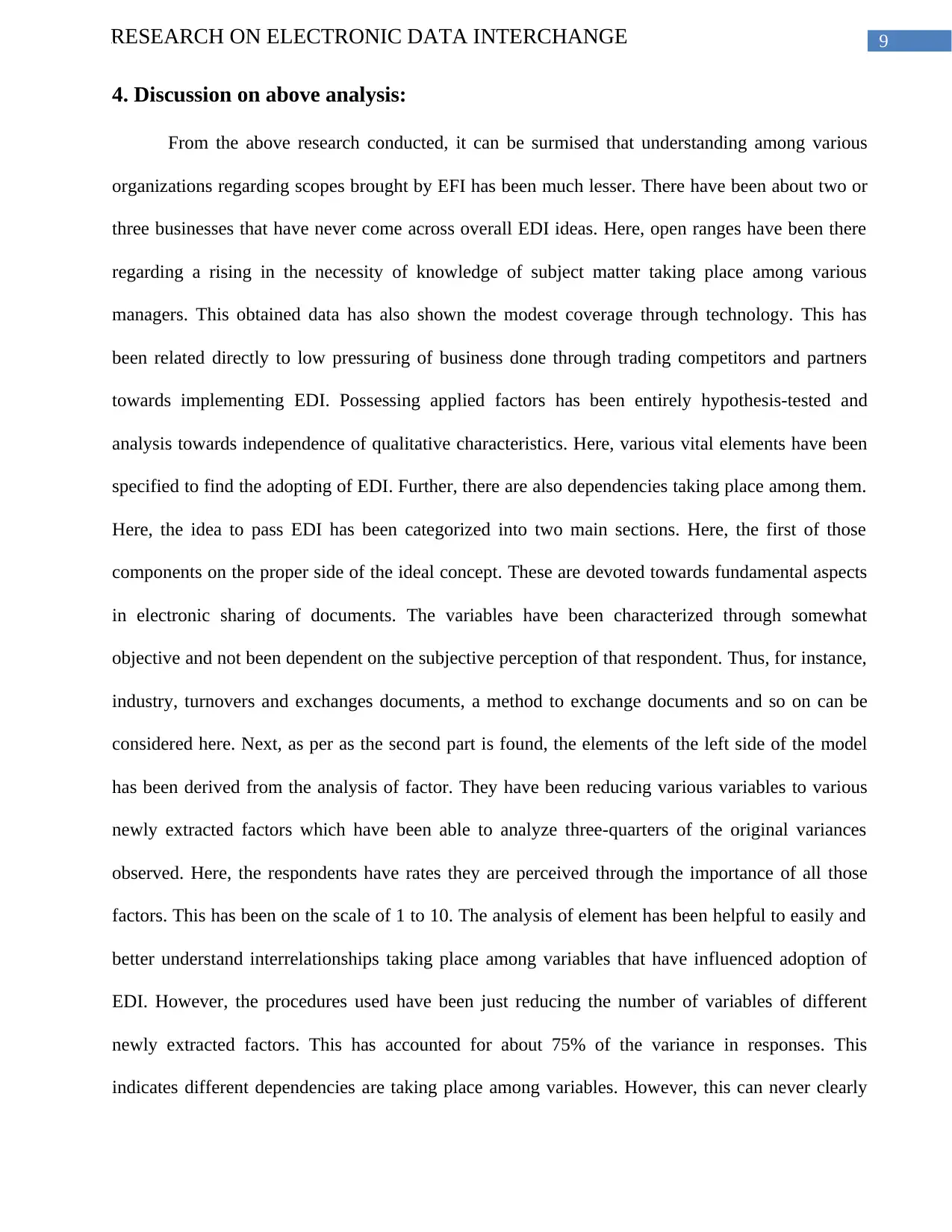
9RESEARCH ON ELECTRONIC DATA INTERCHANGE
4. Discussion on above analysis:
From the above research conducted, it can be surmised that understanding among various
organizations regarding scopes brought by EFI has been much lesser. There have been about two or
three businesses that have never come across overall EDI ideas. Here, open ranges have been there
regarding a rising in the necessity of knowledge of subject matter taking place among various
managers. This obtained data has also shown the modest coverage through technology. This has
been related directly to low pressuring of business done through trading competitors and partners
towards implementing EDI. Possessing applied factors has been entirely hypothesis-tested and
analysis towards independence of qualitative characteristics. Here, various vital elements have been
specified to find the adopting of EDI. Further, there are also dependencies taking place among them.
Here, the idea to pass EDI has been categorized into two main sections. Here, the first of those
components on the proper side of the ideal concept. These are devoted towards fundamental aspects
in electronic sharing of documents. The variables have been characterized through somewhat
objective and not been dependent on the subjective perception of that respondent. Thus, for instance,
industry, turnovers and exchanges documents, a method to exchange documents and so on can be
considered here. Next, as per as the second part is found, the elements of the left side of the model
has been derived from the analysis of factor. They have been reducing various variables to various
newly extracted factors which have been able to analyze three-quarters of the original variances
observed. Here, the respondents have rates they are perceived through the importance of all those
factors. This has been on the scale of 1 to 10. The analysis of element has been helpful to easily and
better understand interrelationships taking place among variables that have influenced adoption of
EDI. However, the procedures used have been just reducing the number of variables of different
newly extracted factors. This has accounted for about 75% of the variance in responses. This
indicates different dependencies are taking place among variables. However, this can never clearly
4. Discussion on above analysis:
From the above research conducted, it can be surmised that understanding among various
organizations regarding scopes brought by EFI has been much lesser. There have been about two or
three businesses that have never come across overall EDI ideas. Here, open ranges have been there
regarding a rising in the necessity of knowledge of subject matter taking place among various
managers. This obtained data has also shown the modest coverage through technology. This has
been related directly to low pressuring of business done through trading competitors and partners
towards implementing EDI. Possessing applied factors has been entirely hypothesis-tested and
analysis towards independence of qualitative characteristics. Here, various vital elements have been
specified to find the adopting of EDI. Further, there are also dependencies taking place among them.
Here, the idea to pass EDI has been categorized into two main sections. Here, the first of those
components on the proper side of the ideal concept. These are devoted towards fundamental aspects
in electronic sharing of documents. The variables have been characterized through somewhat
objective and not been dependent on the subjective perception of that respondent. Thus, for instance,
industry, turnovers and exchanges documents, a method to exchange documents and so on can be
considered here. Next, as per as the second part is found, the elements of the left side of the model
has been derived from the analysis of factor. They have been reducing various variables to various
newly extracted factors which have been able to analyze three-quarters of the original variances
observed. Here, the respondents have rates they are perceived through the importance of all those
factors. This has been on the scale of 1 to 10. The analysis of element has been helpful to easily and
better understand interrelationships taking place among variables that have influenced adoption of
EDI. However, the procedures used have been just reducing the number of variables of different
newly extracted factors. This has accounted for about 75% of the variance in responses. This
indicates different dependencies are taking place among variables. However, this can never clearly
Paraphrase This Document
Need a fresh take? Get an instant paraphrase of this document with our AI Paraphraser
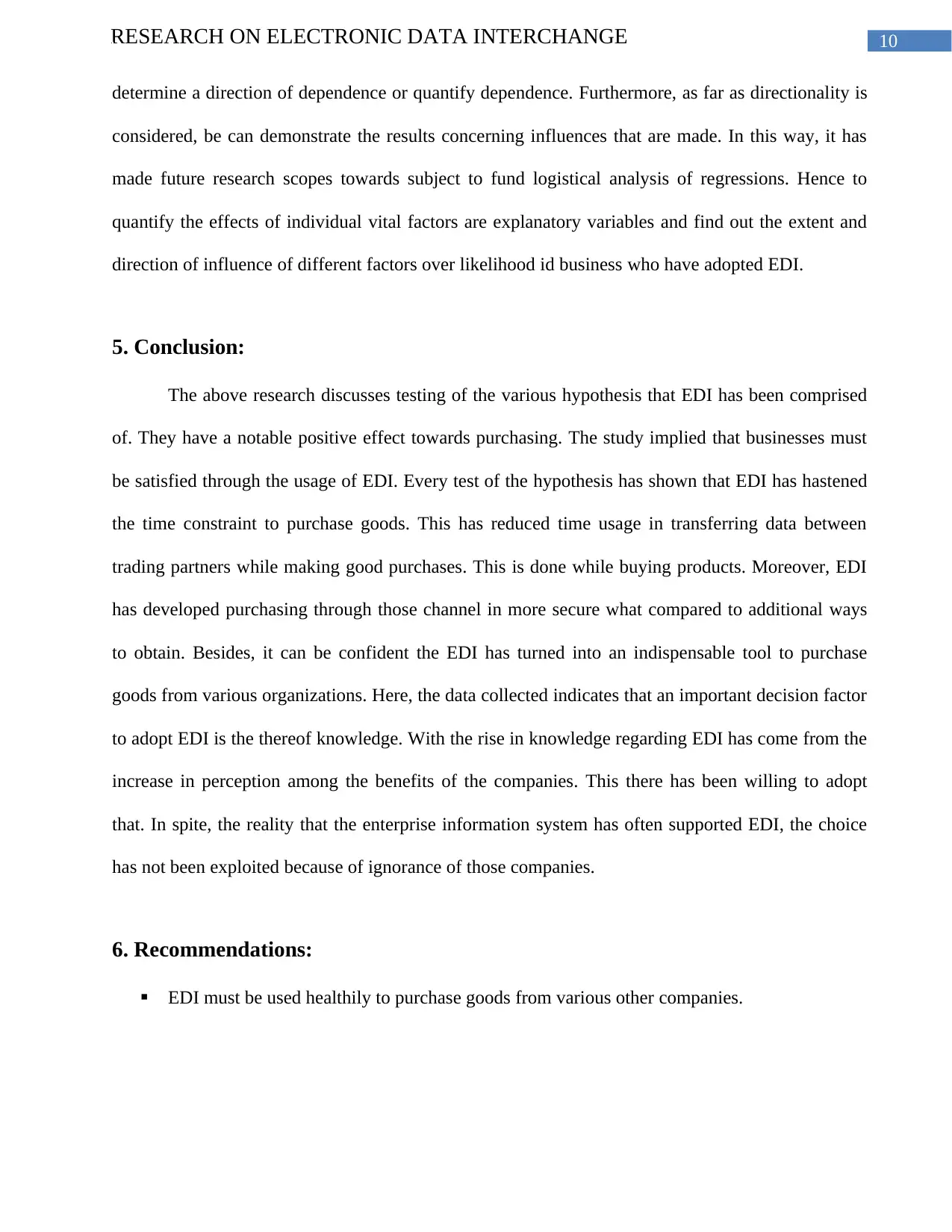
10RESEARCH ON ELECTRONIC DATA INTERCHANGE
determine a direction of dependence or quantify dependence. Furthermore, as far as directionality is
considered, be can demonstrate the results concerning influences that are made. In this way, it has
made future research scopes towards subject to fund logistical analysis of regressions. Hence to
quantify the effects of individual vital factors are explanatory variables and find out the extent and
direction of influence of different factors over likelihood id business who have adopted EDI.
5. Conclusion:
The above research discusses testing of the various hypothesis that EDI has been comprised
of. They have a notable positive effect towards purchasing. The study implied that businesses must
be satisfied through the usage of EDI. Every test of the hypothesis has shown that EDI has hastened
the time constraint to purchase goods. This has reduced time usage in transferring data between
trading partners while making good purchases. This is done while buying products. Moreover, EDI
has developed purchasing through those channel in more secure what compared to additional ways
to obtain. Besides, it can be confident the EDI has turned into an indispensable tool to purchase
goods from various organizations. Here, the data collected indicates that an important decision factor
to adopt EDI is the thereof knowledge. With the rise in knowledge regarding EDI has come from the
increase in perception among the benefits of the companies. This there has been willing to adopt
that. In spite, the reality that the enterprise information system has often supported EDI, the choice
has not been exploited because of ignorance of those companies.
6. Recommendations:
EDI must be used healthily to purchase goods from various other companies.
determine a direction of dependence or quantify dependence. Furthermore, as far as directionality is
considered, be can demonstrate the results concerning influences that are made. In this way, it has
made future research scopes towards subject to fund logistical analysis of regressions. Hence to
quantify the effects of individual vital factors are explanatory variables and find out the extent and
direction of influence of different factors over likelihood id business who have adopted EDI.
5. Conclusion:
The above research discusses testing of the various hypothesis that EDI has been comprised
of. They have a notable positive effect towards purchasing. The study implied that businesses must
be satisfied through the usage of EDI. Every test of the hypothesis has shown that EDI has hastened
the time constraint to purchase goods. This has reduced time usage in transferring data between
trading partners while making good purchases. This is done while buying products. Moreover, EDI
has developed purchasing through those channel in more secure what compared to additional ways
to obtain. Besides, it can be confident the EDI has turned into an indispensable tool to purchase
goods from various organizations. Here, the data collected indicates that an important decision factor
to adopt EDI is the thereof knowledge. With the rise in knowledge regarding EDI has come from the
increase in perception among the benefits of the companies. This there has been willing to adopt
that. In spite, the reality that the enterprise information system has often supported EDI, the choice
has not been exploited because of ignorance of those companies.
6. Recommendations:
EDI must be used healthily to purchase goods from various other companies.
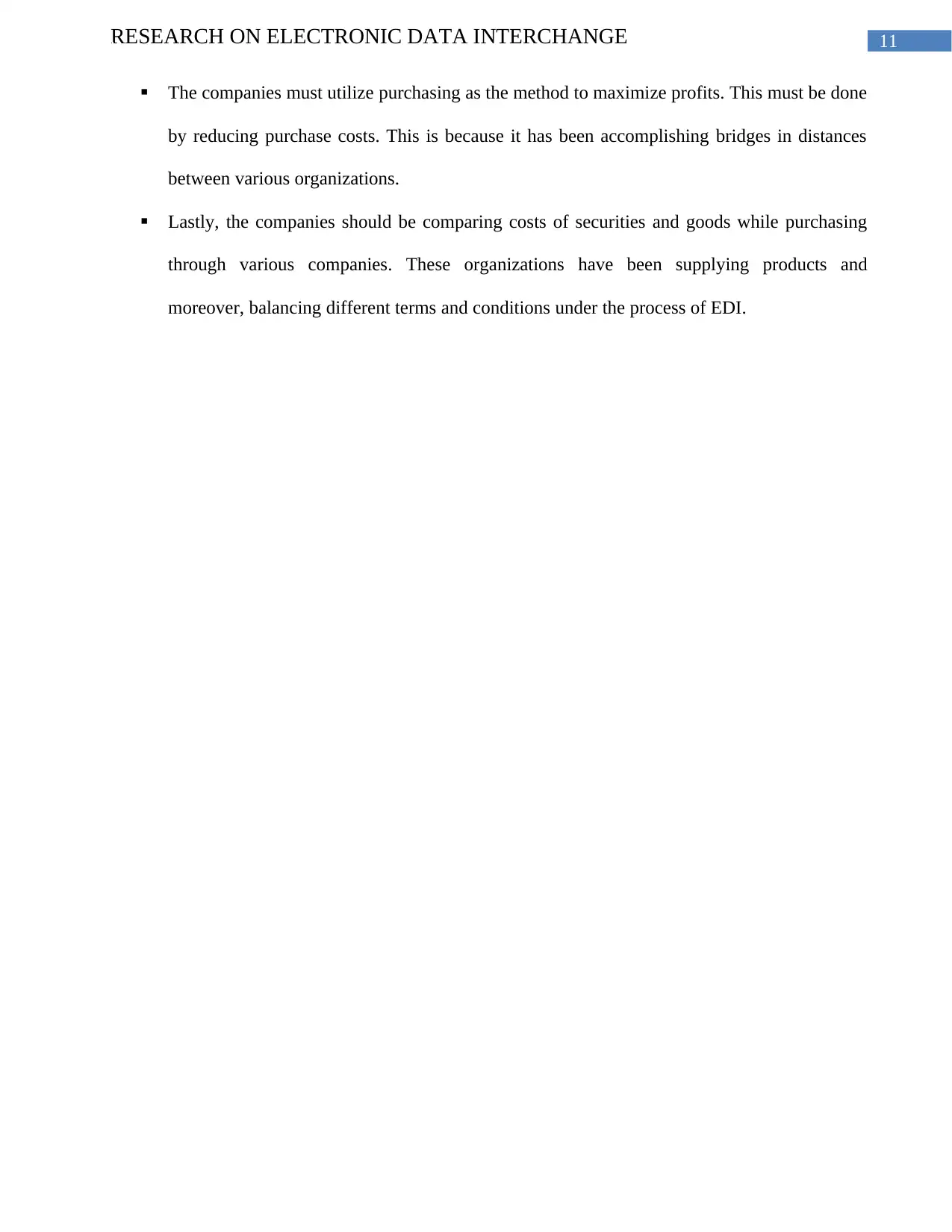
11RESEARCH ON ELECTRONIC DATA INTERCHANGE
The companies must utilize purchasing as the method to maximize profits. This must be done
by reducing purchase costs. This is because it has been accomplishing bridges in distances
between various organizations.
Lastly, the companies should be comparing costs of securities and goods while purchasing
through various companies. These organizations have been supplying products and
moreover, balancing different terms and conditions under the process of EDI.
The companies must utilize purchasing as the method to maximize profits. This must be done
by reducing purchase costs. This is because it has been accomplishing bridges in distances
between various organizations.
Lastly, the companies should be comparing costs of securities and goods while purchasing
through various companies. These organizations have been supplying products and
moreover, balancing different terms and conditions under the process of EDI.
⊘ This is a preview!⊘
Do you want full access?
Subscribe today to unlock all pages.

Trusted by 1+ million students worldwide
1 out of 15
Related Documents
Your All-in-One AI-Powered Toolkit for Academic Success.
+13062052269
info@desklib.com
Available 24*7 on WhatsApp / Email
![[object Object]](/_next/static/media/star-bottom.7253800d.svg)
Unlock your academic potential
Copyright © 2020–2025 A2Z Services. All Rights Reserved. Developed and managed by ZUCOL.




